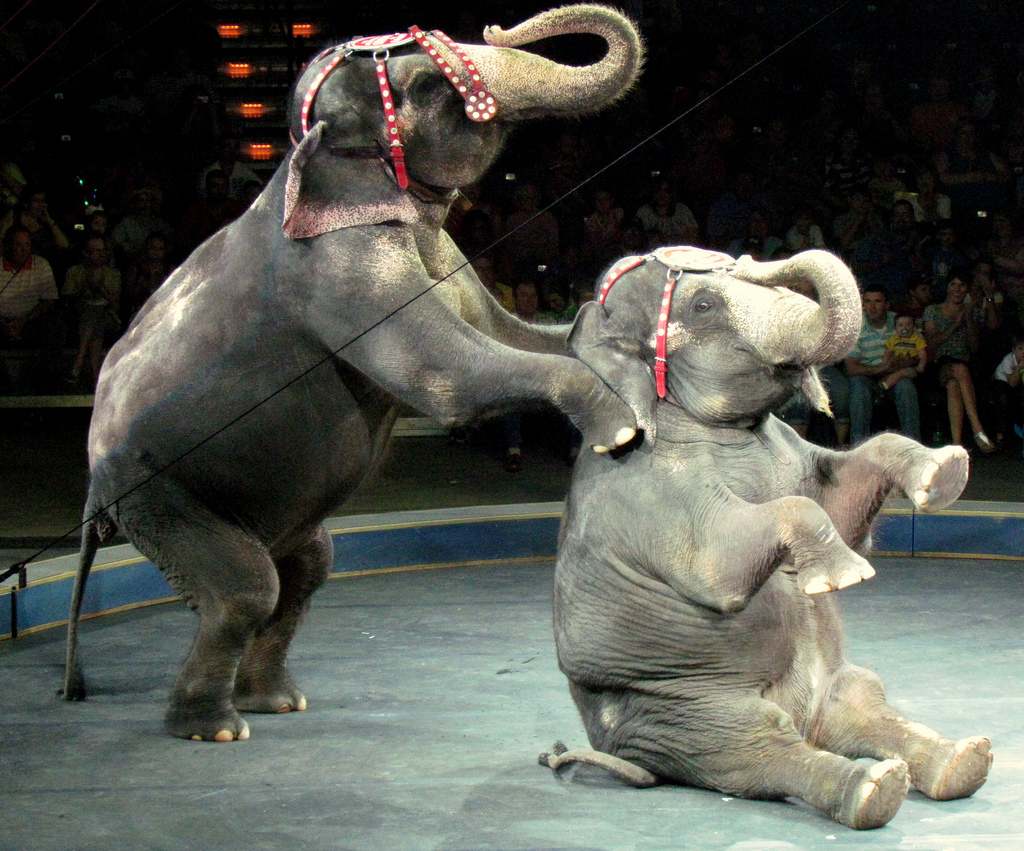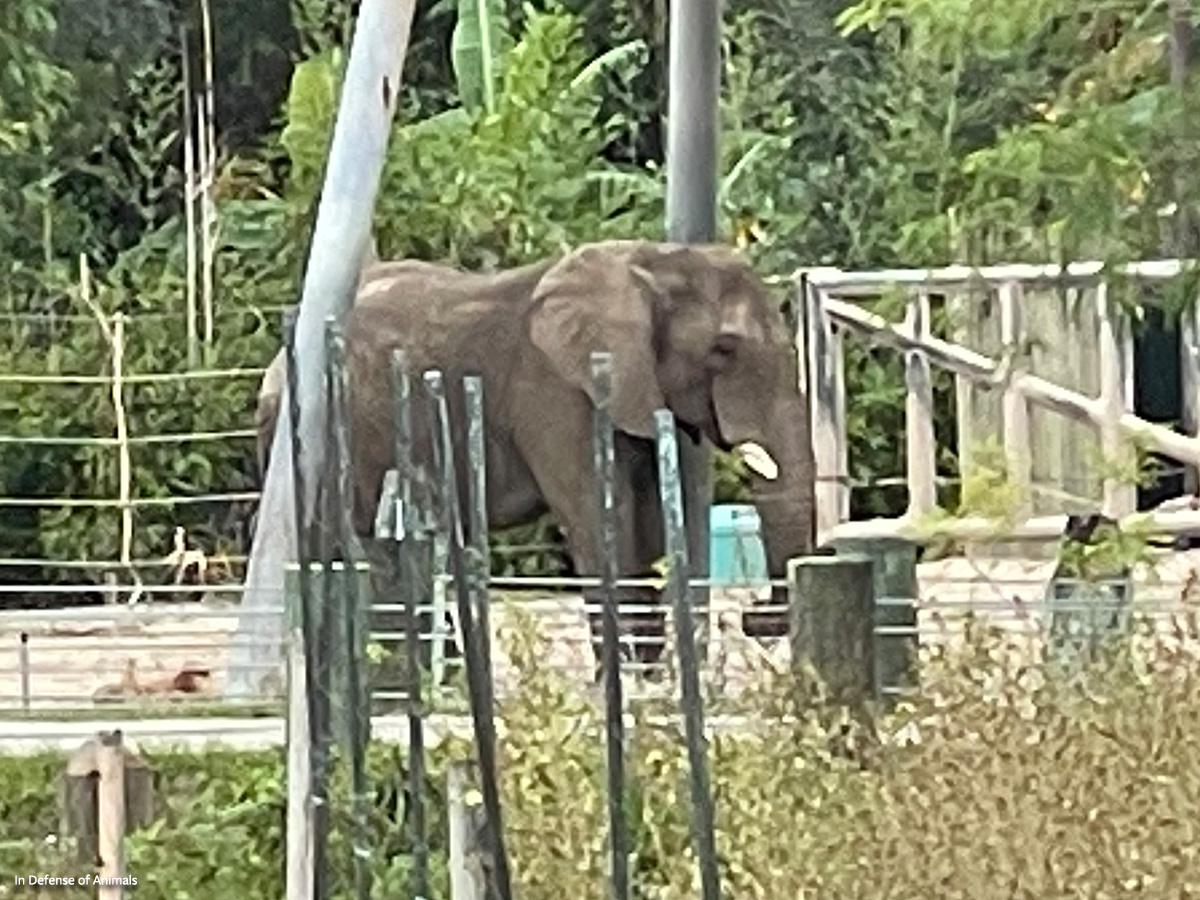In Defense of Animals has a proven commitment to ending elephant captivity
The goal of In Defense of Animals' Elephant Campaign is to end elephant exploitation through eliminating demand for elephant captivity in zoos, as well as their capture, killing or harassment in the wild, through public education and advocacy.
Around 393 elephants are currently imprisoned in North American zoos, circuses, and private properties, including those kidnapped from the wild or born in captivity. Some elephants have been held in solitary confinement, without any other elephants to keep them company, for decades. Many of them appear on our list of the 10 worst zoos for elephants.
- The Issue with Elephants in Captivity and Circuses
- How We Help End Elephant Captivity
- Take Action against Elephant Captivity
- Latest Elephant News
Elephant Captivity
Elephants are highly complex, social animals. In the wild, they live in extended family groups. Elephants form lifelong bonds and females stay with their mothers, aunts, sisters and other female relatives for their entire lives. Males stay with their mothers for up to 15 years. These intelligent animals can travel many miles a day.
Today’s zoos are unable to meet the great physical, psychological and social needs of elephants. Most zoos confine elephants to exhibits a few acres or less in size, a tiny fraction of an elephants’ natural home range. They socially deprive elephants by keeping them in unnaturally small groups of often unrelated individuals who are serially transferred from zoo to zoo. Many of these zoos claim that they are somehow providing a sanctuary for elephants; this couldn’t be further from the truth.

Elephants suffer in zoos and die long before their natural lifespan
Harmful zoo conditions and practices shorten elephant lifespan by decades. Elephants live longer in the wild than in captivity, even when droughts and poaching are taken into account. Captive female Asian elephants in North America have a median life expectancy of 36 years, compared to 42 years for wild elephants who were forced to work in an Asian logging camp! One study of Asian elephants in European zoos found they had a median lifespan of just 19 years! Captive African elephants fare even worse, with an average lifespan of just 33 years in North America, compared to 56 years for free-ranging elephants in Kenya’s Amboseli National Park. For elephants, captivity kills.
Confinement in small spaces leads to brain damage. Our 2021 list of the 10 Worst Zoos for Elephants highlights a breakthrough study by neuroscience professor Bob Jacobs and other leading scientists. It concludes that elephants, among other large-brained mammals, suffer a deterioration of brain function when forced to live in small captive environments. The outer evidence of zoo brain damage is zoochosis — the repetitive, stereotypical behavior endemic to zoos and marine parks. The minuscule space and the lack of stimulation or ability to roam, forage or exercise in zoos are all contributing factors that diminish brain size and function. Zoo captives suffer thinning of the cerebral cortex — the part of the brain involved in voluntary movement and higher cognitive function, including memory, planning, and decision-making. Read the study summary here.
Captivity in zoos is not conservation for elephants. Zoos sell a conservation con, falsely claiming that exhibiting elephants is part of efforts to ensure the species’ survival. In fact zoos are consumers, not conservers, of elephants. Zoo captive breeding programs fail to sustain the population of captive elephants — elephants die faster in zoos than they can reproduce. Instead of conserving wild elephant habitats, zoos take elephants from the wild to restock their dwindling elephant populations. Wild elephant populations, already threatened by habitat loss and illegal poaching, face additional threats from zoo collectors.
Elephants in Circuses
Elephants in circuses are trained with physical punishment: bullhooks, whips, electrical prods and other devices are routinely used to inflict pain and fear to force elephants to perform.
In circuses, elephants are held against their will and denied all the conditions they need to thrive.
- Elephants in circuses are forced to spend days at a time chained in cramped train cars or trucks, eating and sleeping in their own excrement, exposed to temperature extremes, for much of their lives. When not in transit, they are chained or confined in tiny pens, usually on concrete which is extremely harmful to elephants.
- Elephants in circuses are forced to perform unnatural tricks that are often damaging to their bodies.
- Elephants in circuses often display neurotic behavior, such as swaying and head-bobbing, from boredom and severe stress.
- Elephants in circuses suffer from painful foot and joint disease, a leading cause of premature death in captive elephants, from standing too long on hard surfaces and in their own waste.
- Elephants in circuses frequently contract or are exposed to a human strain of tuberculosis (TB). TB is known to thrive in the cramped, close quarters that they are forced to endure day in and day out. Elephants known to be suffering from TB have been forced into contact with the public, causing risks of Zoo-related disease.

Elephants in circuses are held against their will and denied all the conditions they need to thrive.
Most elephants performing in circuses today were captured from the wild, violently separated from their mothers, and shipped to the US when they were very young. Every Asian elephant taken from the wild has endured a brutal breaking process known as “the crush”, which involves beatings with nail-studded sticks, sleep-deprivation, hunger, and thirst, to break the animal’s spirit.
Elephants born into captivity in circuses are routinely torn from their mothers as infants younger than two years old, for training and performance.
Circuses do not contribute in any way to elephant conservation. The brutality of circus life kills elephants so quickly that the death rate exceeds the birth rate.
No baby elephant born to a circus will ever be returned to the wild. The few captive breeding programs that exist in circuses are all about replenishing the supply of tormented performers who will die prematurely as the result of their treatment and living conditions.
What We Do To Protect Elephants
- We publish the annual 10 Worst Zoos for Elephants list, which exposes the worst zoo failings and raises the profile of captive elephant suffering across the nation.
- We act as a watchdog for zoos failing elephants and as an advocate for the transfer of elephants to sanctuaries.
- We call for a permanent end to zoo elephant exhibits, including any and all bogus breeding activities, and for the transfer of victims to accredited sanctuaries. Since 1991, over 30 zoos in North America have closed or are closing their exhibits.
- We lobby for elephants to remain in the wild where they belong, and for stronger laws to protect them.
What You Can Do To Protect Elephants
- Fight elephant captivity and exploitation by signing up to become an Animal Advocate with a regular gift to In Defense of Animals
- Encourage your friends and family to visit real elephant sanctuaries instead of zoos — and use our 10 Worst Zoos list to show them how captivity kills elephants!
- Don’t visit any circus which uses elephants or other animals for entertainment
- Take action against elephant captivity by signing our alerts
- Educate yourself and others about elephant captivity by reading our latest news on elephants
99% RANGE RESTRICTION
wild: 2,470 acres (minimum)
zoos: 1.6 to 10 acres
CAPTIVE ELEPHANTS
live shorter, disease-ridden lives













